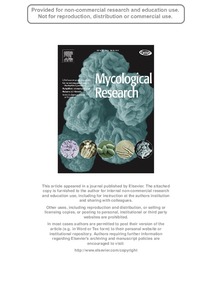| dc.contributor.author | Abang, Mathew M. |
| dc.contributor.author | Abraham, W.R. |
| dc.contributor.author | Asiedu, Robert |
| dc.contributor.author | Hoffmann, P. |
| dc.contributor.author | Wolf, G. |
| dc.contributor.author | Winter, S. |
| dc.date.accessioned | 2019-12-04T11:11:42Z |
| dc.date.available | 2019-12-04T11:11:42Z |
| dc.date.issued | 2009 |
| dc.identifier.citation | Abang, M.M., Abraham, W.R., Asiedu, R., Hoffmann, P., Wolf, G. & Winter, S. (2009). Secondary metabolite profile and phytotoxic activity of genetically distinct forms of Colletotrichum gloeosporioides from yam (Dioscorea spp.). Mycological Research, 113(1), 130-140. |
| dc.identifier.issn | 0953-7562 |
| dc.identifier.uri | https://hdl.handle.net/20.500.12478/2481 |
| dc.description.abstract | Highly virulent, slow-growing grey (SGG); moderately virulent, fast-growing salmon (FGS); and avirulent/weakly virulent, fast-growing grey (FGG) forms of Colletotrichum gloeosporioides have been described from yam (Dioscorea spp.), but little is known about their chemodiversity or the role of toxins in their pathogenesis. Secondary metabolite profiles in high performance tlc (hptlc) showed that the pathogenic SGG and FGS forms have a chemotype (A or B) that is distinct from the non-pathogenic FGG form (chemotype C). Crude extracts of 35-d-old Czapek–Dox yeast broth cultures of FGS and SGG isolates caused tissue necrosis on treated yam leaves but not those of FGG isolates. Extracts from uninoculated broth cultures showed no phytotoxic activity. Toxicity of the culture filtrate was not host specific and toxic substances were thermostable. Dioscorea genotypes with varying levels of resistance to anthracnose differed in their sensitivity to crude toxin extract of FGS (Cg33) and SGG (Cg25) isolates, indicating that these extracts may be useful in evaluating host resistance to anthracnose in vitro. Analysis of two toxin fractions unique to the pathogenic FGS and SGG forms using hlpc, mass spectrometry and nuclear magnetic resonance suggested the presence of a low molecular weight amide peptide. However, possibly due to low yield and the presence of impurities, the chemical structure of the compound(s) could not be fully elucidated. |
| dc.description.sponsorship | German Academic Exchange Service |
| dc.format.extent | 130-140 |
| dc.language.iso | en |
| dc.subject | Anthracnose |
| dc.subject | Chemotype |
| dc.subject | Chromatography |
| dc.subject | Colletotrichum Gloeosporioides |
| dc.subject | Dioscorea Spp. |
| dc.subject | Mass Spectrometry |
| dc.subject | Metabolite Profiling |
| dc.subject | Nmr |
| dc.subject | Phytotoxin |
| dc.title | Secondary metabolite profile and phytotoxic activity of genetically distinct forms of Colletotrichum gloeosporioides from yam (Dioscorea spp.) |
| dc.type | Journal Article |
| dc.description.version | Peer Review |
| cg.contributor.affiliation | Deutsche Sammlung von Mikroorganismen und Zellkulturen |
| cg.contributor.affiliation | Helmholtz Center for Infection Research |
| cg.contributor.affiliation | International Institute of Tropical Agriculture |
| cg.contributor.affiliation | Georg-August-Universität Göttingen |
| cg.coverage.region | Acp |
| cg.coverage.region | Europe |
| cg.coverage.country | Germany |
| cg.authorship.types | CGIAR and advanced research institute |
| cg.iitasubject | Yam |
| cg.iitasubject | Plant Diseases |
| cg.iitasubject | Tissue Culture |
| cg.iitasubject | Genetic Improvement |
| cg.journal | Mycological Research |
| cg.howpublished | Formally Published |
| cg.accessibilitystatus | Limited Access |
| local.dspaceid | 93232 |
| cg.identifier.doi | https://dx.doi.org/10.1016/j.mycres.2008.09.004 |

